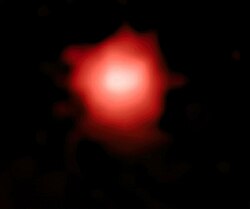Astronomy:GLASS-z13
From HandWiki
Short description: Galaxy
| GLASS-z13 | |
|---|---|
 Close-up view of GLASS-z13 from the James Webb Space Telescope | |
| Observation data (J2000 epoch) | |
| Constellation | Sculptor |
| Right ascension | 00h 13m 59.76s[1] |
| Declination | −30° 19′ 29.1″[1] |
| Redshift | 13.1+0.8 −0.7[1] 12.4±0.2[1] 12.30–12.35[2] |
| Distance | |
| Apparent magnitude (V) | 27.0 AB (F200W)[1] |
| Characteristics | |
| Mass | ≈1.0×109 M☉ |
| Size | ~3000 ly (1 kpc) |
| Half-light radius (physical) | 500 pc |
| Other designations | |
| GHZ2[2][5] | |
References: [1] | |
GLASS-z13 is a candidate Lyman-break galaxy discovered by the Grism Lens-Amplified Survey from Space (GLASS) observing program using the James Webb Space Telescope in July 2022.[6] It is currently one of the earliest and most distant galaxy ever discovered, dating back to just 329.8 million years after the Big Bang, 13.787 billion years ago.[7] The galaxy has an estimated redshift of approximately z = 13.1.[1] GLASS-z13 has a light-travel distance (lookback time) of 13.4572 billion years, and, due to the expansion of the universe, a present proper distance of 33.205 billion light-years.[4] It was discovered alongside another galaxy, GLASS-z11, comparable to GN-z11, also one of the oldest galaxies discovered.[8]
See also
References
- ↑ 1.0 1.1 1.2 1.3 1.4 1.5 1.6 "Two Remarkably Luminous Galaxy Candidates at z ≈ 11 − 13 Revealed by JWST". July 2022. arXiv:2207.09434 [astro-ph.GA].
- ↑ 2.0 2.1 "Early results from GLASS-JWST. III: Galaxy candidates at z∼9-15". July 2022. arXiv:2207.09436 [astro-ph.GA].
- ↑ 3.0 3.1 O'Callaghan, Jonathan (20 July 2022). "JWST has found the oldest galaxy we have ever seen in the universe". New Scientist. https://www.newscientist.com/article/2329601-jwst-has-found-the-oldest-galaxy-we-have-ever-seen-in-the-universe/. Retrieved 20 July 2022.
- ↑ 4.0 4.1 Kempner, Joshua (2022). "KEMPNER Cosmology Calculator". Kempner.net. https://www.kempner.net/cosmic.php. Retrieved 6 August 2022. KEMP Cosmology Calculator - Set H0=67.4 and OmegaM=0.315 (see Table/Planck2018 at "Lambda-CDM model")
- ↑ Koren, Marina (22 July 2022). "The Webb Space Telescope Is a Time Machine Observed". The Atlantic. https://www.theatlantic.com/science/archive/2022/07/james-webb-telescope-image-most-distant-galaxy/670616/. Retrieved 22 July 2022.
- ↑ O'Callaghan, Jonathan (14 September 2022). "JWST’s First Glimpses of Early Galaxies Could Break Cosmology - The James Webb Space Telescope’s first images of the distant universe shocked astronomers. Is the discovery of unimaginably distant galaxies a mirage, or a revolution?". Scientific American. https://www.scientificamerican.com/article/jwsts-first-glimpses-of-early-galaxies-could-break-cosmology/. Retrieved 16 September 2022.
- ↑ Planck Collaboration (2020). "Planck 2018 results. VI. Cosmological parameters". Astronomy & Astrophysics 641: page A6 (see PDF page 15, Table 2: "Age/Gyr", last column). doi:10.1051/0004-6361/201833910.
- ↑ Schneider, Jaron (20 July 2022). "James Webb Telescope Breaks Record for Oldest Galaxy Ever Observed". PetaPixel. https://petapixel.com/2022/07/20/james-webb-telescope-breaks-record-for-oldest-galaxy-ever-observed/. Retrieved 20 July 2022.


